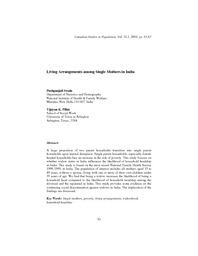
ATTENTION: The works hosted here are being migrated to a new repository that will consolidate resources, improve discoverability, and better show UTA's research impact on the global community. We will update authors as the migration progresses. Please see MavMatrix for more information.
Show simple item record
| dc.contributor.author | Swain, Pushpanjali | en_US |
| dc.contributor.author | Pillai, Vijayan K. | en_US |
| dc.date.accessioned | 2012-05-03T15:32:47Z | en_US |
| dc.date.available | 2012-05-03T15:32:47Z | en_US |
| dc.date.issued | 2005 | en_US |
| dc.identifier.citation | Published in the Canadian Studies in Population 32.1:53-67, 2005. | en_US |
| dc.identifier.issn | 0380-1489 | en_US |
| dc.identifier.uri | http://hdl.handle.net/10106/9691 | en_US |
| dc.description.abstract | A large proportion of two parent households transition into single parenthouseholds upon marital disruption. Single parent households, especially femaleheaded households face an increase in the risk of poverty. This study focuses onwhether widow status in India influences the likelihood of household headshipin India. This study is based on the most recent National Family Health Survey1998-1999, in India. The population of interest includes all mothers aged 15 to49 years, without a spouse, living with one or more of their own children under18 years of age. We find that being a widow increases the likelihood of being ahousehold head compared to the likelihood of household headship among thedivorced and the separated in India. This study provides some evidence on thecontinuing social discrimination against widows in India. The implication of thefindings are discussed. | en_US |
| dc.language.iso | en_US | en_US |
| dc.publisher | Canadian Population Studies | en_US |
| dc.subject | single mothers | en_US |
| dc.subject | poverty | en_US |
| dc.subject | living arrangements | en_US |
| dc.subject | widowhood | en_US |
| dc.subject | household headship | en_US |
| dc.title | Living arrangements among single mothers in India | en_US |
| dc.type | Article | en_US |
| dc.identifier.externalLink | http://www.uta.edu/ra/real/editprofile.php?onlyview=1&pid=333 | en_US |
| dc.identifier.externalLinkDescription | Link to Research Profiles | en_US |
Files in this item
- Name:
- CSPv32n1p53.pdf
- Size:
- 506.3Kb
- Format:
- PDF
- Description:
- PDF
This item appears in the following Collection(s)
Show simple item record


